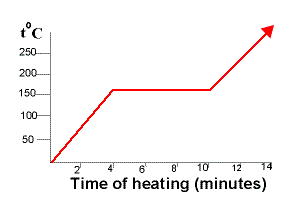Footnotes
1. A region in which all the physical and chemical properties are uniformly the same is referred to as a phase.
A pure substance is composed of only one phase.
A given phase may be solid, liquid or gaseous.
2. An homogeneous mixture is composed of one phase.
Because gases mix completely, any mixture of gases will be composed of 1 phase and will be homogeneous.
A soluble salt dissolved in liquid water to make an aqueous solution of salt is also composed of only phase.
A soluble liquid like ethanol dissolved in liquid water is also composed of only one phase.
3. A heterogeneous mixture is composed of more than one phase.
4. H2O is the molecular formula for water, it tells us that 2 hydrogen atoms and 1 oxygen atom are present in each molecule of water.
You can find out more in the molecular formula tutorial.
5. Iron sulfide is the name given to the compound containing 1 "atom" of iron and 1 "atom" of sulfur based on its composition.
You could name this as a binary inorganic ionic compound (a salt) in which case the preferred IUPAC name is iron(2+) sulfide.
An older IUPAC name for the same compound is iron(II) sulfide (or iron(II) sulphide).
An even older name for the same compound is ferrous sulfide (or ferrous sulphide).
6. The IUPAC preferred spelling for the element with the chemical symbol S is sulfur not sulphur.
You may still find the old spelling of "sulphur" used to refer to the element sulfur.
7. Atoms of sulfur can be arranged in different ways.
You can read more about this in the allotropes tutorial.
8. The term liquid in chemistry refers to a state (or phase) of matter in which all the "particles" (molecules for example) are identical.
Therefore, a liquid is, by definition, a pure substance.
In common useage, people refer to many types of mixtures as "liquids", for example the cordial in a glass might be referred to as a liquid by a non-chemist but a chemist thinks of this as a mixture known as an aqueous solution because there are a lot of substances dissolved in the water (aqua) to give it flavour and colour.
The most general term for a substance that flows is "fluid". A liquid is a fluid, an aqueous solution is a fluid, and gases are fluids.
9. Oxygen can also exist in a different form known as ozone in which 3 oxygen atoms are chemically bonded to each other (O3).
O2 and O3 are known as allotropes of oxygen.
10. This is NOT a comprehensive list of separation methods. You might also like to read about some techniques chemists use to separate substances from mixtures in the following AUS-e-TUTE tutorials:
Chromatography, Electrophoresis and Mass Spectroscopy
And, there are numerous methods used commercially to separate metals from the ores. You might like to read the following AUS-e-TUTE tutorials on metal extraction:
Metal Extraction Concepts, Carbon Reduction Method of Metal Extraction, Copper Extraction by Smelting, Electrolytic Extraction of Aluminium, Electrolytic Extraction of Sodium, Electrowinning Copper
11. Gold nuggets can be large enough to see lying on the surrounding ground. A gold nugget found like this led to the establishment of the enormous Kalgoorlie gold fields in Western Australia.
You can read more about this in the December 2012 issue of AUS-e-NEWS.
12. Strictly speaking we should refer to this property as ferromagnetism.
Ferromagnetism refers to a strong attraction to a magnetic field and is displayed by the elements iron (Fe), cobalt (Co) and nickel (Ni) in the solid state.
In common useage "magnetism" refers to "ferromagnetism".
There are other types of magnestism:
⚛ paramagnetism, substances with unpaired electrons experience a weak attraction to a magnetic field
⚛ diamagnetism, a very feeble repulsion out of a magnetic field which is experienced by all matter
13. At one time it was thought that the disease Guam Dementia was caused by flour made from toxic cycad seeds.
You can read more about this in the September 2017 issue of AUS-e-NEWS.
14. In common useage, sodium choride (NaCl) is referred to as salt or table salt.
To a chemist, sodium chloride is just one example of a salt.
In chemistry, salts are compounds made up of cations (positively charged ions) and anions (negatively charged ions) which are held together in a three dimensional lattice using electrostatic forces of attraction (ionic bonds).
A salt is therefore an ionic compound made up of two ions, a binary ionic compound.
15. Solar Evaporative Salt Production was discussed in detail in the September 2016 issue of AUS-e-NEWS.
16. When a substance dissolves in the water, the resulting mixture is known as an aqueous solution. The amount of substance dissolved in a given volume of water is known as the concentration of the solution.
You can read more about solutions and concentration in the Solutions Concepts Tutorial.


